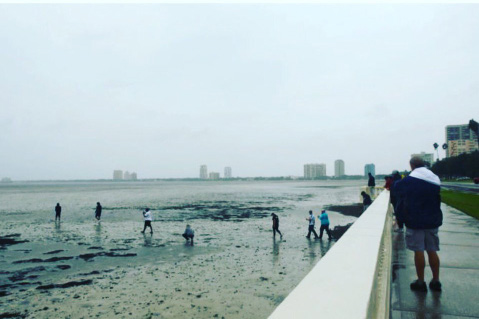[tribulant_slideshow gallery_id=”148″]
By: Travis Farmer
During the events of Hurricane Irma, an odd thing happened to the waters of Tampa Bay during the chaos of the storm. The waters around places like Tampa, Port Charlotte, and The Bahamas, have retreated from the coast due to Hurricane Irma. One video from Long Island in the Bahamas went viral prior to Irma making landfall in Florida. Twitter user Kaydi_K posted the video of the ocean on the northwest side of her island being completely dried up, with people walking out into the “ocean” and being able to see buoys and even a boat grounded in the distance. The user even finds an old lost anchor that they play with a bit.
This viral video prompted many news outlets to report on it, with the Washington Post’s resident meteorologist and weather editor Angela Fritz stating “As a meteorologist, there are things you learn in textbooks that you may never see in person … This is one of those things — a hurricane strong enough to change the shape of an ocean.”
After this viral video took hold, the Tampa Bay area encountered the same phenomena as Long Island experienced. The waters in Tampa Bay receded, leaving the boat markers and seaweed on dry land where the water should have been. Some adventurous Floridians even went out into the bay to take videos and to treasure hunt, with one user on Reddit even stating “get a metal detector stat!’
While many people know that a receding shoreline is a warning of an imminent tsunami or giant wave, in this case, it is actually a symptom of the Hurricane’s massive pressure differential. The water refilled at a rapid rate, but not with a fifty-foot wave that could threaten the entire area.
But why does this happen? Meteorologists explained, on various websites, that the pressure of the storm could act as a vacuum for the water, creating a “bulge” under the center of the storm where the pressure is exceptionally low and the winds are the strongest. This bulge is where all the water from the bay and other areas went. The water returned once the winds shifted, rushing back into the bay with storm surge waves. Some meteorologists, such as Stephen Shiveley from the National Weather Service, stated that this bay receding actually helped save Tampa Bay, as it kept the storm surge and waves much lower during the brunt of the storm.
This “reverse storm surge” left many people confused and bewildered, but none quite as bewildered as some manatees that were grounded in Sarasota Bay during the low tide. Two manatees were noticed by some passersby. Facebook user Marcelo Clavijo said he and some other people helped move the manatees closer to the water in a video that quickly went viral, attracting eight million views after the hurricane.
A marine biologist with the Florida Fish and Wildlife Conservation Commission said that they had received several reports of tidally stranded manatees, but were not going to assist the manatees, as they are used to being tidally stranded sometimes. Nadia Gordon with the Florida FWC told the Bradenton Herald “We’re not actually intervening at this point … Unfortunately, with manatees, they are accustomed to being tidally stranded at times.”
The manatees inaptly named Manatee County are only one example of how a hurricane can affect animals and the ecosystem at large. Hurricanes can destroy habitats, defoliate trees, and reduce food availability. Hurricanescience.org cites one example being the Puerto Rican Parrot; this species is the only the only native parrot in Puerto Rico, and the critically endangered population went from 47 to 23 parrots after Hurricane Hugo in 1989.
It is no doubt that hurricanes are terrifying and powerful, but also, they can be seen as a way to better understand science and our environment. While they destroy ecosystems and drain our water, they leave ways for scientists to better discover how future hurricanes can affect our area and world enlarge.





1 Comment
Top site ,.. amazaing post ! Just keep the work on !